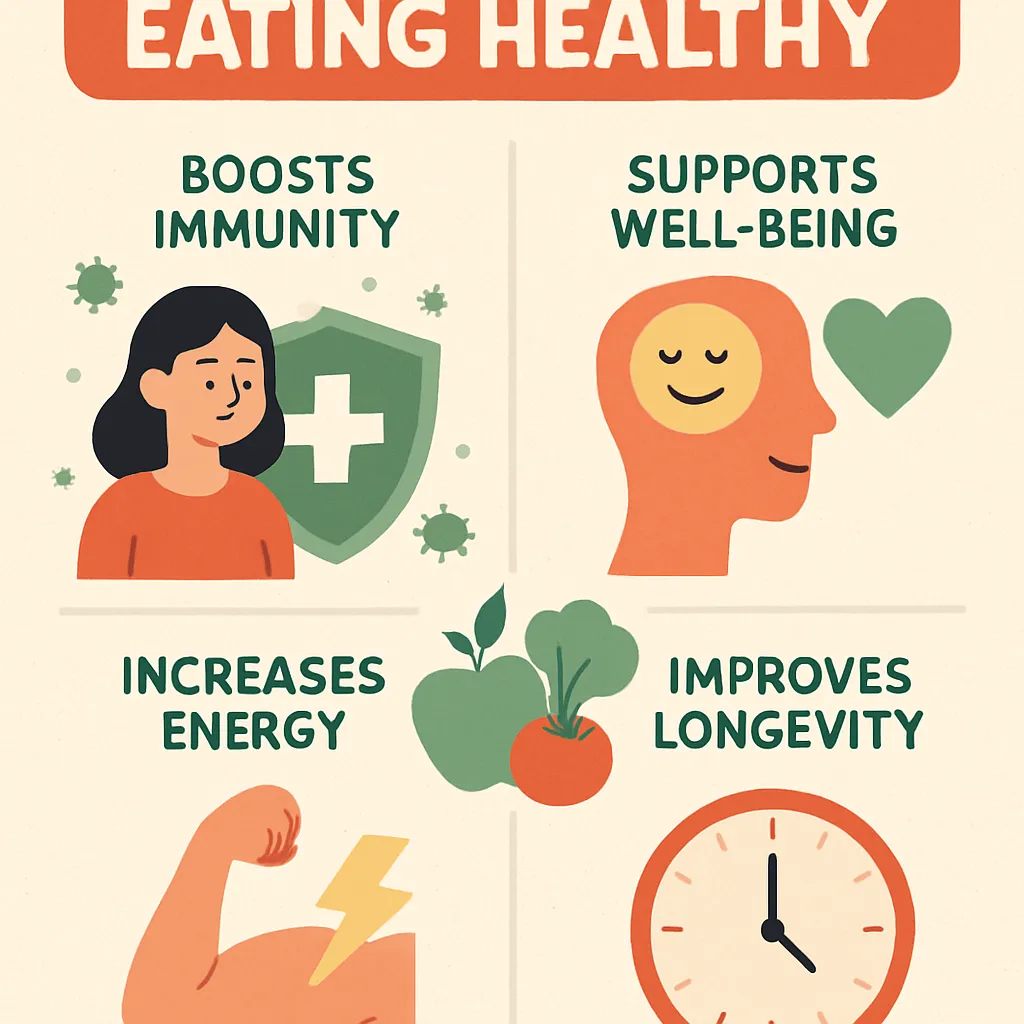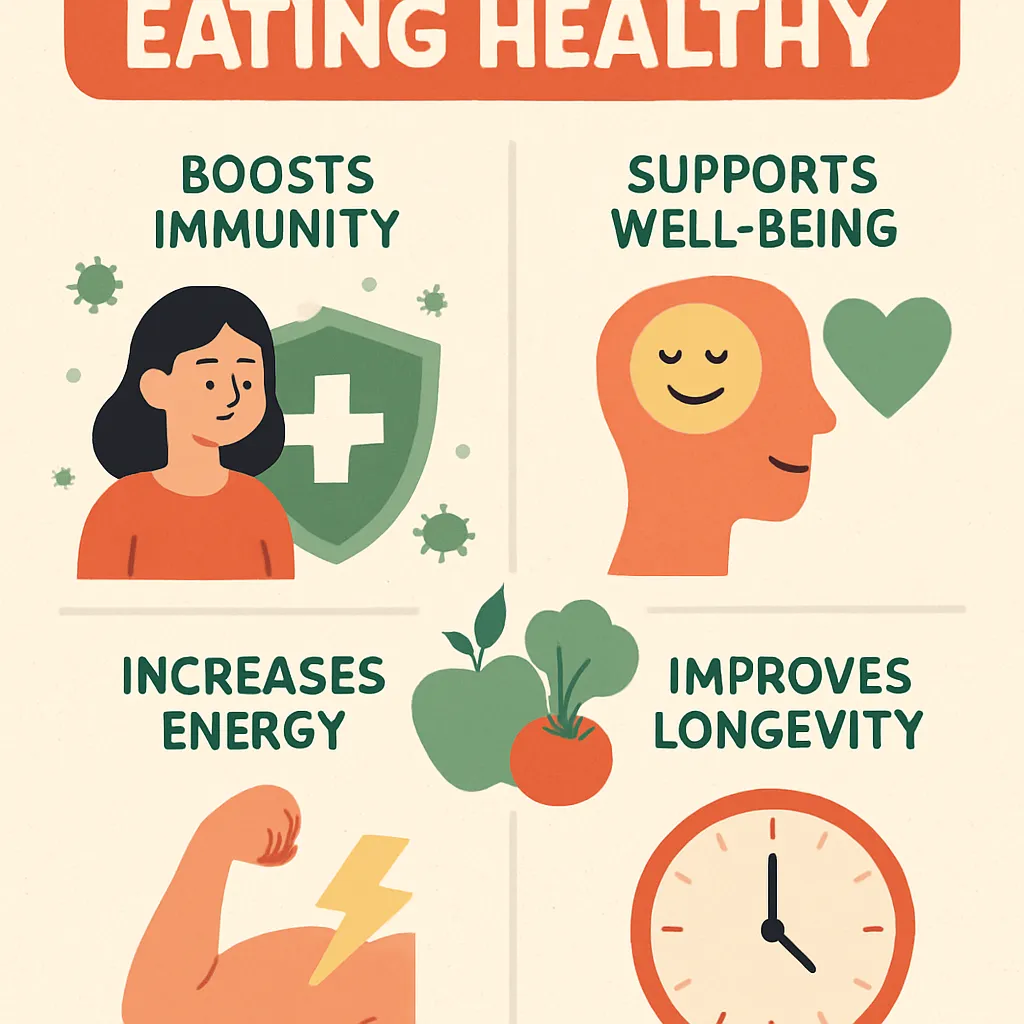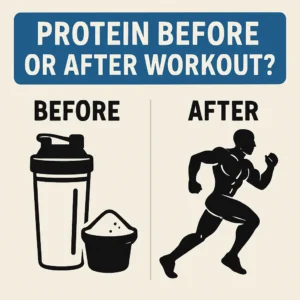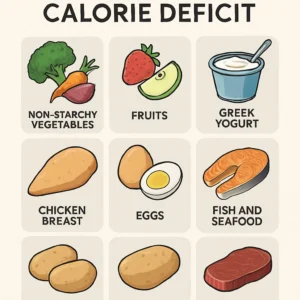What does it truly mean to reap the benefits of eating healthy? At its core, healthy eating is about nourishing your body with the right balance of nutrients to support daily functions and long-term well-being. In this comprehensive article, we’ll explore why a balanced diet is essential, highlight the most compelling advantages of choosing wholesome foods, and share practical tips for making lasting dietary changes. Whether you’re aiming to improve heart health, boost your mood, or manage weight more effectively, understanding the science behind nutrition can empower you to take control of your health. We’ll also delve into strategies for incorporating fruits, vegetables, whole grains, and lean proteins into your meals, while reducing sugar and salt. Finally, we’ll guide you through setting realistic goals and maintaining healthy habits for the long haul.
Introduction to Healthy Eating

Healthy eating refers to consuming a variety of foods that provide the nutrients your body needs to function properly. It involves choosing foods from all the major food groups—fruits, vegetables, whole grains, lean proteins, and low-fat dairy—while limiting processed items high in added sugars, unhealthy fats, and sodium. By prioritizing nutrient-dense options, you supply your body with vitamins, minerals, fiber, and antioxidants that support energy levels and immune function. Adopting a balanced diet also reduces the risk of chronic diseases, such as type 2 diabetes and cardiovascular conditions, by helping regulate blood sugar and cholesterol levels. Moreover, healthy eating promotes sustainable weight management by preventing the overeating associated with high-calorie, nutrient-poor foods. Cultivating mindful eating habits and understanding portion sizes are key skills that will ensure you enjoy meals without feeling deprived.
Understanding a Balanced Diet
A balanced diet delivers the right proportions of macronutrients—carbohydrates, proteins, and fats—and micronutrients—vitamins and minerals—to meet your body’s needs. Complex carbohydrates, found in whole grains and starchy vegetables, provide steady energy and fiber for digestive health. Lean proteins, like poultry, fish, beans, and legumes, support muscle repair and hormone production. Healthy fats, present in nuts, seeds, avocados, and olive oil, assist in nutrient absorption and protect cellular health. Equally important are vitamins and minerals—such as vitamin C, calcium, and iron—which play critical roles in immune defense, bone strength, and oxygen transport. Achieving balance means paying attention not just to individual foods but to overall dietary patterns, ensuring that each meal contains a mix of macronutrients and colorful, nutrient-rich options. Tracking what you eat with a food diary or app can help you recognize gaps or excesses in your current eating habits and guide you toward improvement.
Key Benefits of a Healthy Diet
Embracing healthy eating habits yields a multitude of benefits that extend far beyond weight management. From bolstering cardiovascular function to enhancing mood and sharpening cognitive abilities, the advantages of a balanced diet touch nearly every aspect of physical and mental health. In this section, we’ll unpack the top benefits of adopting nutritious dietary choices and illustrate why they’re invaluable for people of all ages.
Improved Heart Health
Heart health is perhaps the most well-documented area where diet makes a profound impact. Diets rich in fruits, vegetables, whole grains, and lean proteins help lower LDL (“bad”) cholesterol while boosting HDL (“good”) cholesterol. Foods high in soluble fiber—such as oats, beans, and apples—bind cholesterol in the digestive tract and aid its removal from the body. Omega-3 fatty acids found in fatty fish like salmon, as well as flaxseeds and walnuts, reduce inflammation and support healthy blood vessel function. Additionally, limiting saturated and trans fats found in fried foods and processed snacks can prevent arterial plaque buildup. Over time, these combined dietary shifts can lower blood pressure, decrease the risk of heart attack and stroke, and improve overall vascular health.
Enhanced Mood and Mental Health
More than just fuel for the body, food profoundly influences brain chemistry and emotional well-being. Nutrient-dense foods supply the building blocks for neurotransmitters—such as serotonin and dopamine—that regulate mood, sleep, and appetite. For example, B-vitamins, magnesium, and omega-3s are linked to reductions in anxiety and depressive symptoms. Consuming foods high in refined sugars and unhealthy fats, by contrast, can trigger inflammation and oxidative stress in the brain, contributing to mood swings and mental fatigue. Whole grains, lean proteins, and leafy greens offer a steady release of glucose, preventing the “crash” that follows blood sugar spikes. Moreover, staying well-hydrated supports clarity of thought and concentration, which helps you feel more balanced and resilient to stress.
Weight Management and Fitness
Maintaining a healthy weight becomes far more attainable when your diet is centered around whole, unprocessed foods. High-fiber fruits, vegetables, and whole grains increase feelings of fullness, reducing the urge to overeat. Lean protein sources, such as chicken breast, fish, tofu, and beans, require more energy to digest, boosting metabolic rate through the thermic effect of food. Healthy fats from nuts, seeds, and avocados also contribute to satiety by slowing gastric emptying. When paired with regular physical activity, a balanced diet supports muscle growth, endurance, and recovery. Over time, this synergy between nutrition and exercise leads to sustainable weight loss, improved body composition, and better overall fitness.
Reduced Risk of Chronic Diseases
Chronic diseases such as type 2 diabetes, certain cancers, and hypertension are strongly linked to dietary patterns. Diets high in processed meats, refined carbohydrates, and sugary beverages can increase inflammation, insulin resistance, and cell damage. Conversely, plant-forward eating patterns—such as the Mediterranean or DASH diets—have been associated with significantly lower rates of chronic disease. Antioxidants in berries, cruciferous vegetables, and nuts help neutralize harmful free radicals, while phytonutrients in colorful produce modulate gene expression and support cellular repair. A nutrient-rich diet also aids in maintaining healthy blood sugar levels, reducing the likelihood of developing insulin resistance and diabetes.
Below is a table summarizing key nutrients, their food sources, and associated health benefits.
| Key Nutrient | Rich Food Sources | Main Health Benefit |
|---|---|---|
| Omega-3 Fatty Acids | Salmon, Flaxseeds, Walnuts | Supports heart health, reduces inflammation |
| Fiber | Oats, Beans, Berries | Regulates digestion, aids weight management |
| Vitamin C | Citrus Fruits, Bell Peppers, Kale | Boosts immune function, antioxidant protection |
| Calcium | Low-fat Dairy, Leafy Greens, Almonds | Promotes strong bones and teeth |
| B-Vitamins | Whole Grains, Lean Meats, Fortified Cereals | Supports energy metabolism and brain health |
Stronger Bones and Teeth
Calcium and vitamin D are foundational to skeletal integrity, while magnesium and vitamin K support bone density and mineralization. Dairy products, fortified plant milks, leafy green vegetables, and nuts provide these essential nutrients. Weight-bearing activities like walking and resistance training work synergistically with a calcium-rich diet to strengthen bones. Adequate vitamin K, found in broccoli, Brussels sprouts, and fermented foods, activates proteins that anchor calcium in bone tissue. Meanwhile, phosphorus—present in lean meats, dairy, and nuts—works alongside calcium to form the mineral matrix of bones and teeth. Over time, these nutrients and lifestyle factors reduce the risk of osteoporosis and the fractures that can accompany aging.
Enhanced Memory and Cognitive Function
A nutrient-rich diet provides the antioxidants, essential fatty acids, and vitamins that safeguard brain cells and support neural connections. Foods rich in flavonoids—like blueberries, dark chocolate, and green tea—have been linked to improvements in memory and learning. Choline, found in eggs and soybeans, is critical for synthesizing acetylcholine, a neurotransmitter involved in memory formation. Vitamin E, present in nuts and seeds, protects neural membranes from oxidative damage. Combined with regular physical activity and mental challenges, these dietary components form a powerful defense against cognitive decline and age-related memory loss.
Practical Tips for Adopting a Healthy Diet

Transitioning to a healthy diet can feel overwhelming without a clear plan. By setting small, achievable goals and gradually incorporating nutrient-dense foods, you’ll build confidence and sustainable habits. Start by evaluating your current eating patterns and identifying easy swaps—like replacing white rice with quinoa or choosing Greek yogurt over regular varieties. Meal planning and batch cooking can save time and prevent impulsive, less healthy choices. Don’t forget to read nutrition labels: look for lower sodium, minimal added sugars, and recognizable ingredients. Finally, enlist support from friends or family members who share your healthy eating goals to keep you motivated and accountable.
Incorporating Fruits and Vegetables
Fruits and vegetables should make up at least half of your plate at every meal. They’re rich in fiber, vitamins, minerals, and antioxidants, yet low in calories. Aim for a “rainbow” of produce to ensure a diverse range of phytonutrients. Fresh, frozen, and canned (in water or juice) all count equally, making it easier to enjoy variety year-round. When possible, choose seasonal, locally grown options for peak flavor and nutrient density. Finally, experiment with different cooking methods—steaming, roasting, saut?ing—to keep produce exciting and delicious.
Importance of Whole Grains and Lean Proteins
Whole grains and lean proteins are the cornerstones of a balanced diet, supplying energy, sustaining fullness, and supporting muscle health. Swap refined grains like white bread for whole wheat, brown rice, barley, or oats to boost fiber intake. Choose lean cuts of meat, skinless poultry, fish, and plant-based proteins such as tofu, tempeh, and legumes. These foods help maintain stable blood sugar and prevent energy crashes throughout the day. Incorporate a variety of protein sources across the week to cover all essential amino acids and micronutrients. Balance your plate by combining grains and proteins in meals like quinoa and black bean bowls or whole-grain pasta with turkey meatballs.
Reducing Sugar and Salt Intake
Excessive sugar and sodium can undermine the benefits of an otherwise healthy diet. High sugar intake is linked to weight gain, insulin resistance, and dental issues, while too much salt contributes to hypertension and fluid retention. Start by cutting back on sugary drinks, processed snacks, and sweets. Flavor foods with herbs, spices, citrus, and vinegar instead of relying on salt. When buying packaged items, choose “low-sodium” or “no added sugar” versions whenever available. Gradually reducing sugar and salt will recalibrate your taste buds, making naturally sweet and savory foods more satisfying.
Staying Hydrated
Proper hydration is essential for digestion, nutrient transport, temperature regulation, and cognitive performance. Water should be your primary beverage, but herbal teas, sparkling water, and infused water with fruits and herbs are excellent for variety. Aim for at least eight 8-ounce glasses (about 2 liters) daily, adjusting based on activity level, climate, and individual needs. Limit sugary drinks, alcohol, and excessive caffeine, which can dehydrate you or add empty calories. Carry a reusable water bottle to encourage regular sipping and set reminders if necessary. Remember that thirst isn’t always obvious, so make hydration a proactive habit rather than waiting until you feel parched.
- Plan your meals weekly to ensure balanced portions of protein, grains, and produce.
- Prepare healthy snacks—like cut vegetables or mixed nuts—to avoid impulse eating.
- Experiment with one new whole food each week to expand your nutrient profile.
- Use smaller plates to naturally control portion sizes without feeling deprived.
- Track your water intake and set hourly reminders to stay hydrated throughout the day.
Conclusion and Next Steps

Adopting a balanced diet is a journey, not a destination. By focusing on whole, nutrient-rich foods and making gradual changes, you’ll experience improvements in heart health, mood, weight management, and more. Remember that consistency matters more than perfection—occasional indulgences are part of a sustainable healthy lifestyle. Celebrate small victories and reassess your goals regularly to stay motivated. Share your progress with friends or join a community for support and accountability.
Setting Realistic Goals
Start by identifying one or two dietary changes you can commit to for the next month. Maybe it’s adding an extra serving of vegetables at dinner or swapping sugary snacks for fruit. Write these goals down and review them weekly to monitor your success. Adjust as needed—if something isn’t working, pivot to another habit that feels more achievable. Keep goals specific and time-bound, like “eat at least three servings of leafy greens per week” rather than vague intentions.
Maintaining Long-term Healthy Eating Habits
Sustainability is the key to preserving the benefits of healthy eating. Over time, incorporate variety to prevent boredom and ensure a full spectrum of nutrients. Revisit and redefine goals every few months to reflect new challenges, preferences, or life changes. Use tools like meal planning apps, nutrition trackers, or cooking workshops to keep your routine engaging. Finally, continue educating yourself through reputable sources—such as registered dietitians, health organization guidelines, and peer-reviewed research—to stay informed and inspired.
- Review and update your dietary goals every month to maintain progress and prevent plateaus.
- Engage with a community—online or in person—to share tips, recipes, and encouragement.
- Celebrate milestones, like a month of consistent balanced meals, with non-food rewards.
What healthy change will you start today? Your journey to better health begins with one simple choice: selecting nutritious, wholesome foods that fuel your body and mind. Embrace the benefits of eating healthy and enjoy the positive changes that follow!



